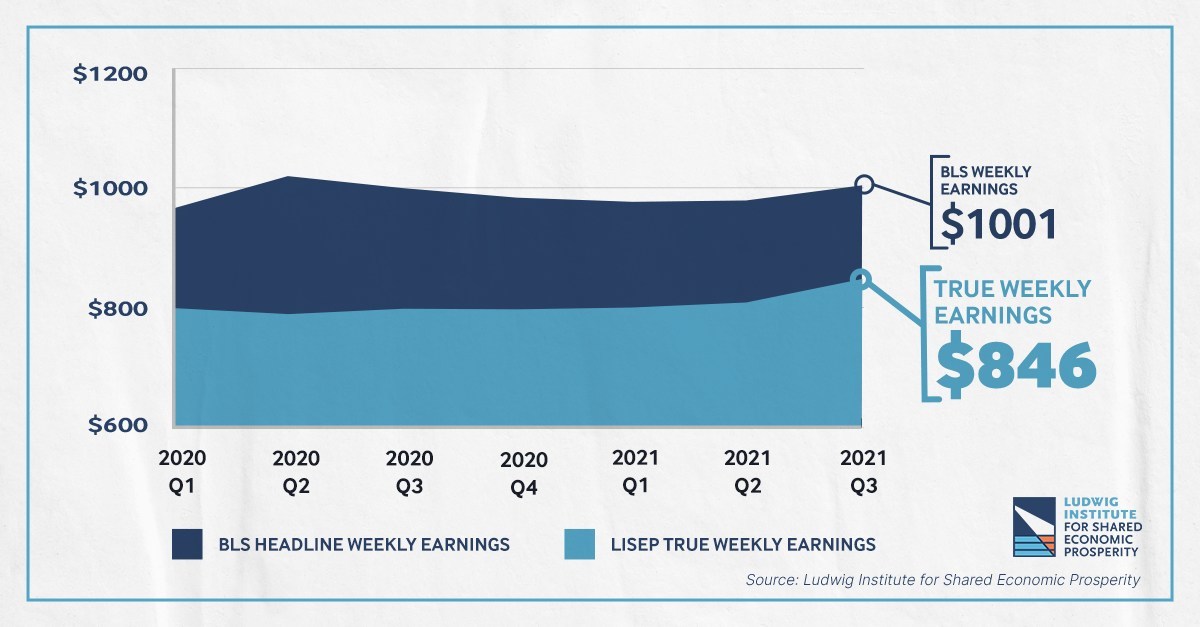Low-income earners post biggest gains in Ludwig Institute’s wage and employment report
More Black workers moved out of the ranks of the “functionally unemployed” and into living-wage jobs for the month of September, with significant wage gains across the board for the third quarter of 2021, according to an analysis by the Ludwig Institute for Shared Economic Prosperity (LISEP), resulting in a narrowing of both the earnings and employment gap.

“It’s great to see progress toward equality emerging in our economic recovery, with significant wage increases for low- and middle-income families and a notable reduction in the employment gap among demographic groups,” said LISEP Chair Gene Ludwig. “We still have a long road ahead of us until there’s a full, equitable recovery, but it is encouraging to see signs that working families are making some gains.”
LISEP issued its monthly True Rate of Unemployment (TRU) for September in conjunction with the quarterly True Weekly Earnings (TWE) report for the third quarter of 2021. TRU is a measure of the functionally unemployed — the jobless, plus those seeking but unable to secure full-time employment paying above the poverty line. TWE is a measure of real median weekly earnings after adjusting for inflation, and differs from the data issued by the Bureau of Labor Statistics (BLS) through inclusion of all members of the workforce, including part-time workers and the unemployed.
The most significant piece of good news for low- and middle-income workers can be found in the TWE report, with overall weekly earnings hitting an all-time high at $846 a week after adjusting for inflation, a 1.93% quarterly increase. Past numbers were also adjusted to Q3 2021 dollars. Black workers saw the biggest gain with an increase of nearly 5% (4.93%, from $660 to $692), while Hispanic workers saw a 2.08% gain ($675 to $689), followed by White workers with a 1.08% increase (from $930 to $946). Earnings for female workers increased faster than for men, jumping from $731 to $745, a 2.0% increase. The male TWE increased just 0.68%, from $940 to $953.
Meanwhile, workers at the lower end of the earnings scale saw the biggest increase, with the 25th percentile earners seeing a 2.5% increase, while earnings for the top, the 90th percentile earners, rose only 0.11%.
“We are seeing some encouraging directional signs of a narrowing of the income inequality gap, albeit slowly,” Ludwig said. “But we are moving in the right direction.”
On the employment front, LISEP determined that the overall TRU, a measure of the percentage of Americans unable to find living-wage jobs, increased by 1.1% in September, from 22.8% to 23.9%. However, the increase can be attributed in part to the yearly release of the Annual Social and Economic Supplement (ASEC) data, which provides new data on the self-employed population. (More information about ASEC’s implications is explained on the LISEP website.) This is in contrast to the Bureau of Labor Statistics (BLS) unemployment report for September, which showed an improvement in the jobless rate, from 5.2% down to 4.8%.
But even with that statistically driven anomaly, the TRU showed some encouraging signs. The Black TRU dropped 0.8%, from 28.7% to 27.9%, compared to an increase in the White TRU, from 21.2% to 22%. With a difference of 5.9%, this is the lowest Black-White gap since the beginning of the pandemic.
“During an economic downturn, low-income workers, particularly Americans of color, are typically the first to lose their jobs and the last to be rehired. The fact that these individuals are finding living-wage jobs, with a real increase in income, is an encouraging sign for communities and our economy,” Ludwig said. “Policymakers should take heed, as this is not the time to take the foot off the gas.”
About TRU
LISEP issued the white paper “Measuring Better: Development of ‘True Rate of Unemployment’ Data as the Basis for Social and Economic Policy” upon announcing the new statistical measure in October. The paper and methodology can be viewed here. LISEP issues TRU one to two weeks following the release of the BLS unemployment report, which occurs on the first Friday of each month. The TRU rate and supporting data are available on the LISEP website at https://www.lisep.org/tru.
About TWE
LISEP issues the TWE quarterly following the release of the BLS Median Weekly Earnings report. The full white paper, “Understanding the Status of American Workers Through Analysis of Current Population Data,” can be viewed here. The TWE rate and supporting data are available on the LISEP website at https://www.lisep.org/earnings.
About LISEP
The Ludwig Institute for Shared Economic Prosperity (LISEP) was created in 2019 by Ludwig and his wife, Dr. Carol Ludwig. The mission of LISEP is to improve the economic well-being of middle- and lower-income Americans through research and education, and seeks to advance the dialogue around policy solutions to improve the well-being of all Americans.
About Gene Ludwig
In addition to his role as LISEP chair, Gene Ludwig is founder of the Promontory family of companies and Canapi LLC, a financial technology venture fund. He is the CEO of Promontory MortgagePath, a technology-based mortgage fulfillment and solutions company, and chairman of Promontory Financial Group. Ludwig is the former vice chairman and senior control officer of Bankers Trust New York Corp., and served as the U.S. Comptroller of the Currency from 1993 to 1998. He is also author of the book The Vanishing American Dream, which investigates the economic challenges facing low- and middle-income Americans. It was released in September 2020 by Disruption Books. On Twitter: @geneludwig.
SOURCE Ludwig Institute for Shared Economic Prosperity

Rod Washington: Rod is a blogger, writer, filmmaker, photographer, daydreamer who likes to cook. Rod produces and directs the web series, CUPIC: Diary of an Investigator. He also produces news and documentary video projects. Check out his podcast StoriesThisMoment at https://m3e.d71.myftpupload.com/stm-tncn-podcasts/


